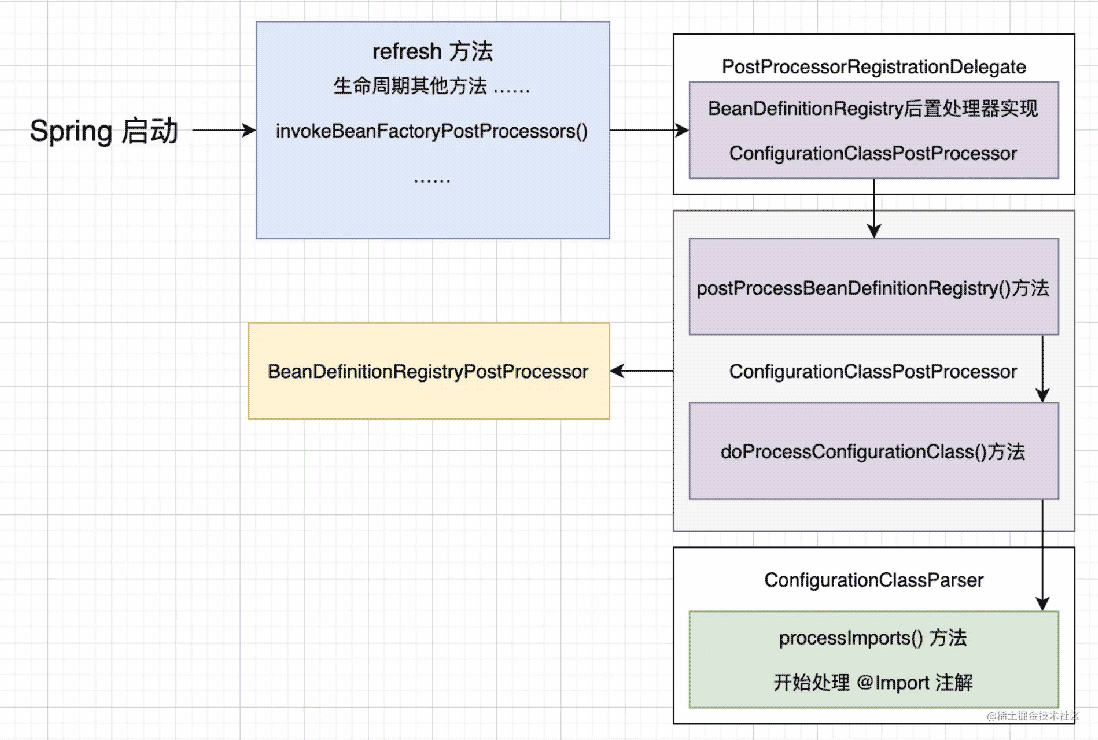我们帮大家精选了相关的编程文章,网友关永怡根据主题投稿了本篇教程内容,涉及到Spring注解@Import、Spring、@Import、Spring注解、Spring注解@Import原理相关内容,已被485网友关注,涉猎到的知识点内容可以在下方电子书获得。
Spring注解@Import原理
正文
在项目开发的过程中,我们会遇到很多名字为 @Enablexxx 的注解,比如@EnableApolloConfig、 @EnableFeignClients、 @EnableAsync 等。他们的功能都是通过这样的注解实现一个开关,决定了是否开启某个功能模块的所有组件的自动化配置,这极大的降低了我们的使用成本。
那么你是好奇过 @Enablexxx 是如何达到这种效果呢,其作用机制是怎么样的呢?
@Import 原理
按照默认的习惯,我们会把某个功能模块的开启注解定义为 @Enablexxx,功能的实现和名字格式其实无关,而是其内部实现,这里用 @EnableAsync 来举例子。
@Target(ElementType.TYPE)
@Retention(RetentionPolicy.RUNTIME)
@Documented
@Import(AsyncConfigurationSelector.class)
public @interface EnableAsync {
……
}
可以看到除了3个通用注解,还有一个@Import(AsyncConfigurationSelector.class)注解,显然它真正在这里发挥了关键作用,它可以往容器中注入一个配置类。
在 Spring 容器启动的过程中,执行到调用invokeBeanFactoryPostProcessors(beanFactory)方法的时候,会调用所有已经注册的 BeanFactoryPostProcessor,然后会调用实现 BeanDefinitionRegistryPostProcessor 接口的后置处理器 ConfigurationClassPostProcessor ,调用其 postProcessBeanDefinitionRegistry() 方法, 在这里会解析通过注解配置的类,然后调用 ConfigurationClassParser#doProcessConfigurationClass() 方法,最终会走到processImports()方法,对 @Import 注解进行处理,具体流程如下。
如果这部分流程不是很理解,推荐详细阅读一下 Spring 生命周期相关的代码,不过不重要,不影响理解后面的内容。

@Import 注解的功能是在ConfigurationClassParser类的 processImports()方法中实现的,对于这个方法我已经做了详细的注释,请查看。
private void processImports(ConfigurationClass configClass, SourceClass currentSourceClass,
Collection<SourceClass> importCandidates, Predicate<String> exclusionFilter,
boolean checkForCircularImports) {
// 如果使用@Import注解修饰的类集合为空,直接返回
if (importCandidates.isEmpty()) {
return;
}
// 通过一个栈结构解决循环引入
if (checkForCircularImports && isChainedImportOnStack(configClass)) {
this.problemReporter.error(new CircularImportProblem(configClass, this.importStack));
}
else {
// 添加到栈中,用于处理循环import的问题
this.importStack.push(configClass);
try {
// 遍历每一个@Import注解的类
for (SourceClass candidate : importCandidates) {
// 1.
// 检验配置类Import引入的类是否是ImportSelector子类
if (candidate.isAssignable(ImportSelector.class)) {
// Candidate class is an ImportSelector -> delegate to it to determine imports
// 候选类是一个导入选择器->委托来确定是否进行导入
Class<?> candidateClass = candidate.loadClass();
// 通过反射生成一个ImportSelect对象
ImportSelector selector = ParserStrategyUtils.instantiateClass(candidateClass, ImportSelector.class,
this.environment, this.resourceLoader, this.registry);
// 获取选择器的额外过滤器
Predicate<String> selectorFilter = selector.getExclusionFilter();
if (selectorFilter != null) {
exclusionFilter = exclusionFilter.or(selectorFilter);
}
// 判断引用选择器是否是DeferredImportSelector接口的实例
// 如果是则应用选择器将会在所有的配置类都加载完毕后加载
if (selector instanceof DeferredImportSelector) {
// 将选择器添加到deferredImportSelectorHandler实例中,预留到所有的配置类加载完成后统一处理自动化配置类
this.deferredImportSelectorHandler.handle(configClass, (DeferredImportSelector) selector);
}
else {
// 获取引入的类,然后使用递归方式将这些类中同样添加了@Import注解引用的类
// 执行 ImportSelector.selectImports
String[] importClassNames = selector.selectImports(currentSourceClass.getMetadata());
Collection<SourceClass> importSourceClasses = asSourceClasses(importClassNames, exclusionFilter);
// 递归处理,被Import进来的类也有可能@Import注解
processImports(configClass, currentSourceClass, importSourceClasses, exclusionFilter, false);
}
}
// 2.
// 如果是实现了ImportBeanDefinitionRegistrar接口的bd
else if (candidate.isAssignable(ImportBeanDefinitionRegistrar.class)) {
// Candidate class is an ImportBeanDefinitionRegistrar ->
// delegate to it to register additional bean definitions
// 候选类是ImportBeanDefinitionRegistrar -> 委托给当前注册器注册其他bean
Class<?> candidateClass = candidate.loadClass();
ImportBeanDefinitionRegistrar registrar =
ParserStrategyUtils.instantiateClass(candidateClass, ImportBeanDefinitionRegistrar.class,
this.environment, this.resourceLoader, this.registry);
/**
* 放到当前configClass的importBeanDefinitionRegistrars中
* 在ConfigurationClassPostProcessor处理configClass时会随之一起处理
*/
configClass.addImportBeanDefinitionRegistrar(registrar, currentSourceClass.getMetadata());
}
else {
// Candidate class not an ImportSelector or ImportBeanDefinitionRegistrar ->
// process it as an @Configuration class
// 候选类既不是ImportSelector也不是ImportBeanDefinitionRegistrar-->将其作为@Configuration配置类处理
this.importStack.registerImport(
currentSourceClass.getMetadata(), candidate.getMetadata().getClassName());
/**
* 如果Import的类型是普通类,则将其当作带有@Configuration的类一样处理
*/
processConfigurationClass(candidate.asConfigClass(configClass), exclusionFilter);
}
}
}
catch (BeanDefinitionStoreException ex) {
……
finally {
this.importStack.pop();
}
}
}
上述代码的核心逻辑无非就是如下几个步骤。
- 找到被 @Import 修饰的候选类集合,依次循环遍历。
- 如果该类实现了
ImportSelector接口,就调用ImportSelector的selectImports()方法,这个方法返回的是一批配置类的全限定名,然后递归调用processImports()继续解析这些配置类,比如可以 @Import 的类里面有 @Import 注解,在这里可以递归处理。 - 如果被修饰的类没有实现
ImportSelector接口,而是实现了ImportBeanDefinitionRegistrar接口,则把对应的实例放入importBeanDefinitionRegistrars这个Map中,等到ConfigurationClassPostProcessor处理 configClass 的时候,会与其他配置类一同被调用ImportBeanDefinitionRegistrar的registerBeanDefinitions()方法,以实现往 Spring 容器中注入一些 BeanDefinition。 - 如果以上的两个接口都未实现,则进入 else 逻辑,将其作为普通的 @Configuration 配置类进行解析。
所以到这里,你应该明白 @Import 的作用机制了吧。对上述逻辑我总结了一张图,如下。

示例 @EnableAsync
继续之前提到的 @EnableAsync 作为例子,源码如下。
@Target(ElementType.TYPE)
@Retention(RetentionPolicy.RUNTIME)
@Documented
@Import(AsyncConfigurationSelector.class)
public @interface EnableAsync {
Class<? extends Annotation> annotation() default Annotation.class;
boolean proxyTargetClass() default false;
AdviceMode mode() default AdviceMode.PROXY;
int order() default Ordered.LOWEST_PRECEDENCE;
}
//
@Override
public final String[] selectImports(AnnotationMetadata importingClassMetadata) {
……
// 获取 Mode
AdviceMode adviceMode = attributes.getEnum(getAdviceModeAttributeName());
// 模板方法,由子类去实现
String[] imports = selectImports(adviceMode);
if (imports == null) {
throw new IllegalArgumentException("Unknown AdviceMode: " + adviceMode);
}
return imports;
}
public class AsyncConfigurationSelector extends AdviceModeImportSelector<EnableAsync> {
@Override
@Nullable
public String[] selectImports(AdviceMode adviceMode) {
switch (adviceMode) {
case PROXY:
return new String[] {ProxyAsyncConfiguration.class.getName()};
case ASPECTJ:
return new String[] {ASYNC_EXECUTION_ASPECT_CONFIGURATION_CLASS_NAME};
default:
return null;
}
}
}
它通过 @Import 注解引入了AsyncConfigurationSelector配置类,它继承了 AdviceModeImportSelector 类,而后者实现了 ImportSelector 接口,里面的实现了一个由注解指定 mode 属性来决定返回的配置类的逻辑,而 mode 的默认值就是 AdviceMode.PROXY。

对应 switch 逻辑,将返回 ProxyAsyncConfiguration类的全限定名。这就对应了 @Import 处理逻辑的第一个 if 逻辑块,它将会解析这个类,然后递归调用processImports(),再次进入此方法,进入第三个else逻辑块,将其当作一个普通配置类解析。可以看到 ProxyAsyncConfiguration 其实就是 @Configuration 类,它的作用是注册一个 Bean 对象 AsyncAnnotationBeanPostProcessor。
@Configuration
@Role(BeanDefinition.ROLE_INFRASTRUCTURE)
public class ProxyAsyncConfiguration extends AbstractAsyncConfiguration {
@Bean(name = TaskManagementConfigUtils.ASYNC_ANNOTATION_PROCESSOR_BEAN_NAME)
@Role(BeanDefinition.ROLE_INFRASTRUCTURE)
public AsyncAnnotationBeanPostProcessor asyncAdvisor() {
……
return bpp;
}
}以上就是Spring注解@Import原理解析的详细内容,更多关于Spring注解@Import原理的资料请关注码农之家其它相关文章!



















